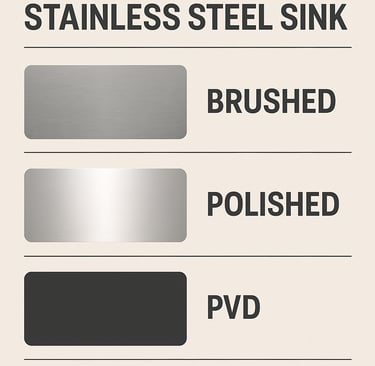Stainless Steel Sink Surface Finishes: What Works Where
From brushed stainless to PVD and nano coatings, explore the strengths and trade‑offs of sink finishes, and see which markets and projects each one truly fits.
Amonars
9/5/20253 min read


Introduction: Why Finish Matters
A sink is more than a piece of hardware. In today’s kitchens and bathrooms, its surface finish shapes the mood of the entire room. It decides how the material ages, how forgiving it is with daily use, and whether the look feels classic or experimental. For developers, distributors, and brand managers, the choice of finish is never just aesthetic—it can influence how a project is perceived years after installation.
Brushed / Satin Finish
Step into a hotel service kitchen or a new apartment in Berlin or Chicago and you’ll almost certainly find brushed stainless. It has earned its reputation: the grain hides wear, the surface stays respectable even after long use, and it carries an association with professional quality. Think of it as the denim of sink finishes—classic, durable, never out of place.
When it works: projects that demand reliability and simple maintenance.
What’s missing: a sense of novelty or dramatic flair.
Polished (Mirror) Finish
A mirror-polished sink has the power to stop people in their tracks under showroom lights. It glitters, it impresses. But place the same sink in a family kitchen, and every fingerprint tells its own story. That’s why you’ll mostly see it in luxury homes or display kitchens—places where drama is worth the upkeep, and practicality takes a back seat.
PVD (Physical Vapor Deposition)
PVD has expanded the language of stainless steel. Suddenly sinks appear in matte black, champagne gold, or deep graphite. When properly applied, the coating bonds strongly and withstands corrosion, offering both variety and toughness. Designers appreciate the mood it brings to a space.
Use it for: premium residential, retail displays, and distinctive e‑commerce lines.
Points to consider: higher cost, and some buyers still prefer the safety of plain steel.
Electroplating
An older technique, electroplating has long been used for bathroom taps and accessories. It can produce bright, decorative surfaces at a relatively low cost. The trade‑off is longevity: under heavy use, the color can wear or fade.
Fits best: budget‑driven markets, secondary fixtures where use is light.
Nano Finish
Nano finish is the newcomer that has turned heads in parts of Asia. The pitch is appealing: anti‑fingerprint, water‑repellent, and a silky dark tone. On a showroom floor, it looks almost futuristic. But hotel operators and large residential developers tend to stay away, and for good reason. Once scratched, the surface is hard to repair, and quality can be inconsistent from one factory to the next.
Good for: retail or e‑commerce where novelty sells, or smaller residential projects where style is a selling point.
Not ideal for: large developments or hospitality spaces where predictability and long‑term wear are essential.
How Markets Diverge
Walk through a European trade fair and you’ll see brushed stainless still ruling the stands, with PVD finishes beginning to mark out a premium tier. Western buyers lean on what has been tested through decades of use in apartments and restaurants. In Asia, the mood is different: consumers are quicker to embrace a fresh look, and nano finishes—with their dark, silky surface—have found an eager audience. Reactions vary widely. Some enjoy the sleek effect, others complain about scratching or uneven performance.
Which Finish Fits Which Project?
- In high‑end residences, PVD brings a quiet richness, while polished steel is chosen when the goal is bold visual drama.
- For retail shelves and showrooms, PVD and nano draw the eye immediately—their colors and textures stand out in crowded aisles.
- Online, these same finishes make a product pop in photos, but sellers need to be upfront: beauty comes with added care.
Conclusion: Nano Finish—Curiosity or Future Standard?
Nano coatings are hard to ignore—they look fresh and different. Yet major Western brands remain cautious, and for good reason: long‑term performance is still uncertain. For projects where hundreds of sinks must perform consistently year after year, brushed and PVD remain the safer choice. Nano, for now, is better treated as a bold accent or a niche option in markets where novelty carries more weight than decades of service. The key for specifiers is to match the finish not only to design goals, but also to the everyday realities of the end user.
Want to compare finishes in real projects?
- Ask for our finish sample guide
- Contact: sales@amonars.com
- Explore OEM and project solutions with Amonars
